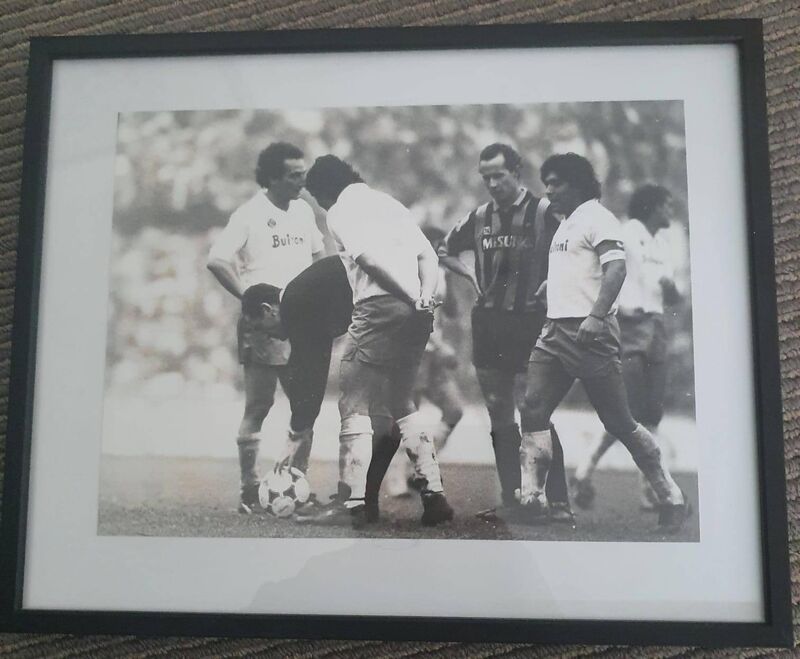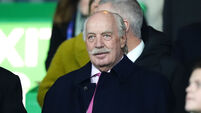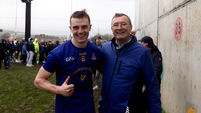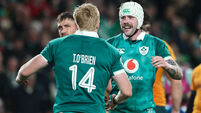Liam Brady: You never saw Maradona let his teammates know they weren't good enough for him

Meeting of Maestros: Ascoli's Liam Brady exchanges pennants with Napoli captain Diego Maradona
It’s the shirt I treasure most. And it’s certainly a rare one — a Maradona Argentina shirt without 10 on the back. It’s number 17. And it’s wrapped up and put away in the same condition it was in when he handed it to me in May, 1979.
Argentina arrived in Dublin, of course, as world champions. As an avid follower of football, I’d read all about this wonderkid who’d been tipped to make the World Cup squad the year before, at just 17.
In the end, Cesar Luis Menotti didn’t think he was ready, but when the champions toured Europe the following summer, on one of those money-spinning jaunts the South American sides take, Maradona had broken in. Though they’d played Italy a few days before and were in Hampden the following weekend to face Scotland, so Diego was on the bench in Dublin.
It was also John Giles’ last ever appearance for Ireland. I was reading through the Examiner report of the game yesterday and Billy George called it “a unique moment and a rare experience... the departure of one seasoned professional and centre stage immediately occupied by a gifted youngster”.
He also wrote that the young Maradona “gave the impression he could catch pigeons”.
That’s my memory of it too, when he came on in the second half at Lansdowne Road.
He was something we'd never seen before. You just couldn't get the ball off him. By the time I faced him later in his career, I knew not to get too close. Just drop off, wait for support, try to crowd him out. It was a case of safety in numbers because he’d dribble anybody one on one.
That night, we just about survived, getting bodies around him, and it finished scoreless. And crucially, I got closest at the final whistle and got the shirt of the best footballer I’ve ever played against.
A few days later, he scored his first goal for Argentina in a 3-1 win over the Scots and I saw former Celtic striker Frank McGarvey say he tore them to shreds. Hampden gave him a standing ovation and the world was waking up to someone who’d take centre stage in all our lives.
I consider him a huge part of mine. First, watching and admiring from afar. The following year he probably played a part in my move to Juventus. Those days, the Italian clubs could only sign one foreign player, and my name was probably fifth or sixth on a list with him close to the top. But for some reason they didn’t get him, and he eventually moved to Barcelona in ‘82. A move that never suited him, because Spanish football was particularly brutal in those days.
Then two years later he arrived in Naples, which suited him down to the ground, in one sense. A place as poor as where he’d come from in Buenos Aires, and as passionate about football.
I played against him about half a dozen times in Italy. Learning not to engage him. It was like he was made of rubber. You could knock him, but he’d half fall over and get up again and be gone.
But something struck me again yesterday as I watched that amazing highlights reel of his performances during the 1986 World Cup. As well as the brilliant goals, and the little bit of Gaelic, there are all those chances he created for others, most of them missed. But you know what you don’t see after any of those misses? Maradona throwing his hands up in the air, having a go at his teammates. Up close, that’s how I remember him too.
I see it all the time now, prima donnas who couldn’t lace Maradona’s boots, making it clear their teammates aren’t up to their standards. Never from him. His teammates loved him dearly.
He was a great bloke to play against too. Sure, he’s got the reputation in England as a cheat, and he got away with one, but I never saw him as a cheat.
He never feigned injury, never went down looking to get somebody booked or sent off. He always bounced up on his feet and he was respectful of his opponents.
I played with Gentile, Bergomi, Vierchowod — ask any of them and they’ll say he was the hardest player to mark. They kicked him and tried everything to stop him. And first thing they all did when the whistle went was ask him for his shirt.
There were times he reacted to the brutality, the tackle on Brazil’s Batista’s that earned him a red card in the 1982 World Cup. But I never classed him as a dirty player, a sneaky player. He wasn’t the kind of guy who’d put his foot over the ball.
I never knew him. We’d shake hands, that was it. He’d chirp away. Another treasure at home is a photo of me taking a penalty for Inter against Napoli at the San Siro. And he’s standing beside me, chatting, trying to put me off. But it was all in good fun.
That one went in, we got the better of him a couple of times, but never in Naples, where he was unplayable. Where he was the king.

Naples was the perfect stage and the worst. A claustrophobic life of adoration where he couldn’t set foot outside his door. He got involved with the mafia — or the Camorra — and all the chaos that entailed.
In Italy then, you could not pass a day without seeing his face, because he was never off the front pages. He could never relax so perhaps that’s what turned him to the darker side of life. What’s incredible is how he could still perform.
I played against him with Inter at White Hart Lane too in 1986, for Ozzie Ardiles’ testimonial. There was a full house to see him in a Spurs shirt.
He was generous that way. He went to Lothar Matthaus’ testimonial for Bayern Munich. He’d play charity games all over the world. If you asked him, and if he knew you and respected you, he’d turn up. And put on a show.
He was similar to George Best in that sense and it’s so poignant they died on the same date. Two geniuses who couldn't cope with the fame. But also very generous and loving people.
When people look back at George, they forget the darker side of life, and remember the joy he brought us. And it’ll be the same with Maradona. The maestro.









